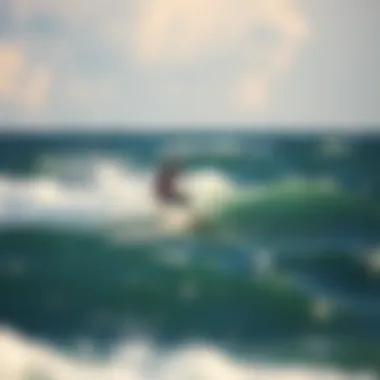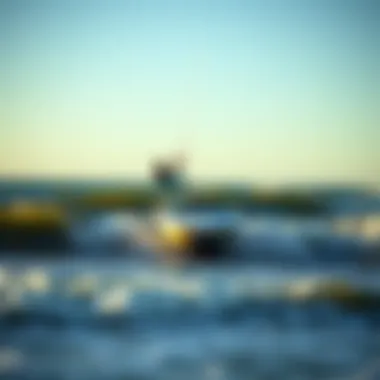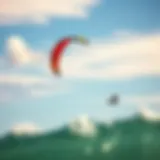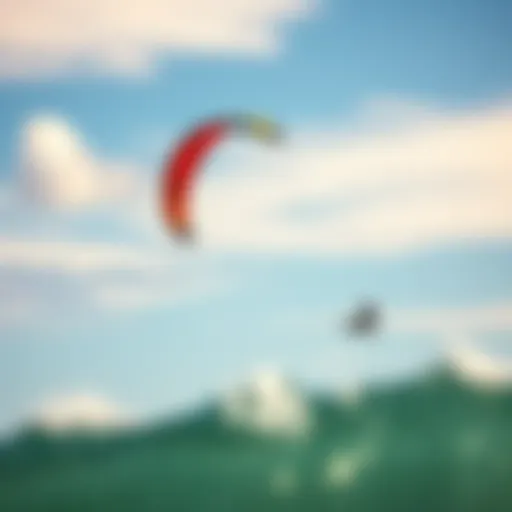Exploring Wind Patterns in the Gulf of Mexico


Intro
The Gulf of Mexico is a vast body of water teeming with possibilities for kiteboarders of all levels. Whether you’re a fledgling enthusiast or a seasoned pro, understanding the wind patterns unique to this region is key to elevating your kiteboarding experience. The intricate dance of air and water here dictates performance and safety, turning a simple outing into a thrilling adventure or a perilous journey.
In this guide, we delve into the important aspects of wind patterns in the Gulf, considering not only their definitions but also how they impact kiteboarding. Through a focused lens on meteorological influences and the latest mapping techniques, we aim to equip kiteboarding enthusiasts with the know-how to navigate these winds confidently. With the right understanding of conditions, from beginner to advanced maneuvers, enthusiasts can maximize their time on the water while minimizing risks. This deep dive will be complemented by expert perspectives and illustrative charts, ensuring that every aspiring kiteboarder has access to essential knowledge.
Techniques for Kiteboarding Enthusiasts
Understanding wind patterns isn't just for meteorologists; it’s crucial for anyone wanting to capture the essence of kiteboarding on the Gulf. Kiteboarding enthusiasts can greatly benefit from a solid grasp of both fundamental and advanced techniques that leverage these winds effectively.
Beginner Techniques
For those just dipping their toes into kiteboarding, it's vital to comprehend the basics of wind and how it drives the kites. Here are some simple strategies:
- Wind Direction Awareness: Always know which way the wind is blowing before you launch your kite. Keeping an eye on the flags or ripples on the water can provide you immediate feedback on wind direction.
- Launching and Landing: Understanding the best positions for launching and landing your kite concerning the wind direction can prevent unfortunate mishaps. Ideally, seek areas where you have plenty of space away from obstacles.
- Control and Steering: Learn to maneuver by utilizing both hands effectively on the bar. An understanding of how tiny adjustments can lead to significant changes in your path is essential.
Advanced Maneuvers
Once you’ve mastered the basics, the next step involves elevating your kiteboarding skills in a way that fully utilizes wind patterns. Key techniques include:
- Riding Upwind: Knowledge of wind angles can help kiteboarders enhance their upwind capabilities. Position your kite at a higher angle when moving against the wind to maximize lift.
- Switching Directions: Practice transitioning between riding regular and switch stance smoothly. This requires an understanding of how to read wind shifts quickly to maintain speed without losing control.
- Using Wind Shifts for Tricks: Advanced kiteboarders can harness gusts and lulls to perform tricks. Timing your jumps with these shifts can yield spectacular airtime and stunts.
"Mastering the art of kiteboarding in the Gulf relies heavily on one’s ability to read the wind. Awareness of these factors can turn a good ride into a memorable one."
By refining your skills with these techniques, you open the door to a more rewarding kiteboarding adventure in the Gulf of Mexico.
Preamble to Gulf of Mexico Winds
The winds that flow across the Gulf of Mexico are not just breezy gusts; they play a pivotal role in the aquatic ecosystem of the region and profoundly impact activities such as kiteboarding. A deep dive into these winds reveals layers of complexity shaped by geography, meteorology, and local conditions. Understanding these elements is crucial for anyone looking to harness the wind's power, whether for sport or safety.
Geographical Overview
The Gulf of Mexico is bordered by the southern United States, Mexico, and Cuba, and stretches over an extensive area of approximately 600,000 square miles. This body of water boasts a varied topography, with coastal bays, wetlands, and numerous islands. The contrasting land and sea temperatures create wind patterns that can be quite dynamic.
From the barrier islands off the coast of Texas to the eroded limestone of Florida, the geographical features influence how winds behave. Coastal currents interact with the land, which can set the stage for both calm days and tumultuous storms. For kiteboarders, knowing these geographical intricacies allows for better decision-making regarding when and where to ride.
Importance of Wind for Kiteboarding
The winds in the Gulf of Mexico are the lifeblood of kiteboarding. Without adequate wind speeds, a day on the water can become a major disappointment. Optimal kiteboarding conditions usually present themselves with steady winds blowing between 12 to 25 knots. Winds that are too weak can leave a kiteboarder stranded, while those exceeding 30 knots can pose safety risks.
"Understanding wind patterns is not just a bonus; it’s a necessity for anyone serious about kiteboarding in the Gulf."
Kiteboarding depends on the wind not only for propulsion but also for jumping and tricks. Each kite responds differently at varying wind speeds, requiring practitioners to adjust their equipment accordingly. Choosing the right gear is paramount. A detailed grasp of wind patterns also minimizes the risk associated with sudden gusts and shifts, making for safer outings.
In essence, the wind patterns in the Gulf of Mexico are central to the kiteboarding experience, determining when to hit the waves and what gear to use. For beginners and advanced kiteboarders alike, understanding these breezy nuances opens the door to thrilling adventure and ensures safe practices on the water.
Meteorological Factors Affecting Wind Patterns
When it comes to grasping how wind behaves in the Gulf of Mexico, diving into the meteorological factors is essential. These elements not only shape the wind but also influence the experiences of kiteboarders whose enjoyment rides on the whims of nature. Understanding these factors helps enthusiasts and instructors prepare and adapt strategies for kiteboarding safely and effectively.
Temperature Variance
Temperature plays a pivotal role in the dynamics of wind patterns. In simple terms, warm air rises while cool air settles, creating a cycle that drives wind movement. On the Gulf, the interplay between land and water temperature can lead to noticeable differences.
- During the day, the sun heats the land more rapidly than the water. This causes the air over land to warm and rise, creating an area of lower pressure. Simultaneously, cooler air over the ocean moves in to fill the gap, generating a gentle sea breeze.
- Conversely, at night, the land cools down quicker than the water. The cooler air over the land becomes denser, leading to a reversal of this pattern where a land breeze may occur. This process can be integral for specific kiteboarding sessions, as timing becomes crucial.
By recognizing these temperature variances, kiteboarders can predict when the winds will be optimal for their sport, ensuring that every outing is as exhilarating as it is safe.
Pressure Systems
Next in line are the pressure systems which are the heartbeat of wind classification. High and low-pressure systems can significantly influence the wind's strength and direction throughout the Gulf.
- High-pressure systems usually bring stable weather with lighter winds, ideal for beginners or those seeking a leisurely ride. Kiteboarding then becomes centered around gentle winds rather than spirited gusts that could send one sailing uncontrollably.
- On the flip side, low-pressure systems are often associated with more turbulent weather patterns. They tend to bring stronger winds and even storms, which are exciting for those with a zest for adventure but potentially hazardous for the unprepared. Those that are accustomed usually leverage this knowledge to find the thrill in conditions that others may find daunting.


Awareness of pressure systems allows kiteboarders to strategize when and where to ride, tailoring their sessions to maximize fun while minimizing risks.
Local Topography
The landscape surrounding the Gulf also plays a significant role in shaping wind patterns. Local topography includes features such as mountains, valleys, and even cities, all of which interact with wind flows in unique ways.
- Coastal regions can experience wind speed increases due to funnelling effects, where landforms channel the air. This can lead to spot-on locations for kiteboarding where those in the know can catch the perfect ride.
- Additionally, obstacles in the terrain may create downdrafts or wind shadows, where the winds are significantly less favorable. Recognizing these areas is vital for players in the sport; avoiding downwind spots can prevent unexpected wipeouts or challenging conditions.
In essence, how the wind dances through the Gulf isn't just a matter of chance. Through a keen understanding of temperature variance, pressure systems, and local topography, kiteboarders can position themselves advantageously in this splendid natural playground. Indeed, these meteorological factors shape not only the winds but also the kiteboarding culture in the Gulf of Mexico.
Wind Mapping Techniques
Understanding the intricacies of wind patterns in the Gulf of Mexico is vital not only for kiteboarding enthusiasts but also for anyone interested in the dynamics of wind behavior. Wind mapping techniques provide the framework for interpreting these patterns, allowing kiteboarders to anticipate conditions, plan their outings more effectively, and enhance safety. In this section, we'll delve into traditional mapping methods, the recent technological advancements that have revolutionized this field, and how these methods get integrated into kiteboarding.
Traditional Mapping Methods
Before technology took the spotlight, wind mapping largely relied on hands-on methods. Kiteboarders, sailors, and meteorologists would chart wind directions using observations from landmark positions along the coastline. One popular technique involved the use of anemometers, devices that measure wind speed. These instruments are often mounted on observation towers or manually held to collect data.
In addition to anemometers, local wind observations from people at various points along the coast formed a crucial part of the mapping equation. Enthusiasts relied on their gut feelings and experience to note patterns over time.
The strength of traditional methods lies in their simplicity; however, they often lacked the depth and immediacy that modern kiteboarders require. With only a subjective point-of-view, such methods could miss critical nuances that dictate safer kiteboarding conditions.
Technological Advancements
In recent years, technology has begun to etch out an impressive role in how we map wind patterns, specifically through:
Satellite Imagery
Satellite imagery represents one of the most potent advancements in wind mapping. By capturing wide swathes of the Gulf and its weather systems, satellite services paint a real-time picture of wind conditions over vast areas. One key characteristic of satellite imagery is its ability to provide comprehensive coverage, which is particularly beneficial for large bodies of water like the Gulf of Mexico.
Its unique feature is the capacity to track changes in cloud formations and surface temperatures, essential indicators of changing wind conditions. The advantages of using satellite imagery are numerous: high-resolution data, accessibility to remote areas, and timely updates. However, one must also consider the downside, including cost and complexity in interpreting the data without the necessary training.
Real-Time Data
Real-time data collection has transformed kiteboarding safety and performance to a new level. Devices that provide live updates enable kiteboarders to assess wind conditions as they change, offering an edge in planning and decision-making. The salient feature of real-time data is its immediacy, offering information that helps riders react promptly to sudden shifts in weather.
With access to this kind of data, kiteboarders can optimize their time on the water and make better-informed choices about when to head out or come back in. Still, users should be aware that reliance on real-time data might promote over-confidence when conditions rapidly shift.
Mobile Applications
In our tech-driven world, mobile applications have bridged the information gap, putting wind mapping tools right into the hands of kiteboarders. These apps aggregate various data sources—including weather stats and localized forecasts—into user-friendly platforms. A standout characteristic of mobile applications is their capacity to provide personalized notifications, which keep users updated about changing wind conditions based on their chosen locations.
The, perhaps, greatest advantage is convenience; kiteboarders no longer need to pore over detailed meteorological reports. These applications offer quick, real-time insights about local wind patterns while often also providing community feedback. On the flip side, users should err on the side of caution, as not all applications provide equally reliable data.
The integration of technology into wind mapping allows for enhanced decision-making, ensuring that kiteboarders prioritize safety while maximizing their performance.
As kiteboarding continues to grow in popularity, understanding both traditional and modern mapping techniques will provide mariners an opportunity to adapt and enjoy the winds of the Gulf with confidence.
Analyzing Wind Patterns in the Gulf of Mexico
Understanding wind patterns in the Gulf of Mexico is crucial not only for kiteboarding enthusiasts but also for various marine activities and weather forecasting. These patterns directly affect the ocean surface, local climate, and consequently, the performance of kiteboarders in this dynamic region. Analyzing wind patterns helps in predicting the best days and locations for kiteboarding, offering a significant advantage in planning outings.
One of the key takeaways when exploring wind patterns is how they vary by season and specific weather events. With kiteboarding heavily reliant on steady winds, knowing these behaviors can be a game-changer. Not just for the thrill-seekers, but also for instructors and water sports coaches looking to provide safe and enjoyable experiences.
Seasonal Variations
Throughout the year, the Gulf of Mexico undergoes notable seasonal changes that significantly influence wind behavior. During summer months, the land heats up more quickly than the water, creating thermal winds that can be ideal for kiteboarding. These conditions often result in consistent onshore winds that kiteboarders crave. On the flip side, winter brings cooler temperatures and can lead to more variable and gusty conditions.
As a kiteboarder, understanding these seasonal variations is vital. You might hit the water only to discover that the wind isn’t cooperating, which is often the case during transitional seasons like spring and fall when weather fronts come in and can stir up unpredictable gusts.
Frequent Wind Events
In the Gulf, certain weather events frequently affect wind patterns and can present both opportunities and challenges for kiteboarders.
Tropical Storms


Tropical storms are one such phenomenon that have a significant impact on wind patterns. They can generate intense wind systems, causing winds to reach impressive speeds, sometimes exceeding 30 knots. While kiteboarders generally steer clear of storms for safety reasons, the remnants of a tropical storm can sometimes lead to ideal kiteboarding conditions. After the storm passes, it can leave behind strong but more manageable winds. The unique feature of tropical storms is their capacity to radically change local wind patterns in a short time, which can be an advantage for experienced kiteboarders.
Advantages of winds from tropical storms:
- Potential for thrilling sessions with strong winds.
- Increased wave action, appealing to advanced kiteboarders looking for challenges.
Disadvantages include:
- Risks associated with sudden changes in weather conditions.
- Safety concerns regarding strong gusts and turbulent waters.
Cold Fronts
Cold fronts also play a key role in shaping wind patterns. When a cold front moves through, it can sharply change the wind direction and intensity. Kiteboarders often experience gusty winds following the passage of a cold front, as air masses shift dramatically.
A key characteristic of cold fronts is their ability to bring cooler, denser air that can boost wind speed. Kiteboarders might find these conditions exhilarating, but they come with trade-offs.
Advantages of cold front winds:
- Often lead to steady and strong winds ideal for kiteboarding.
- Improved potential for clear skies and sun after the front moves through.
Disadvantages can include:
- Gusty winds can be unpredictable, making navigation tricky.
- Cold fronts can lead to temperature drops, impacting the comfort of kiteboarders.
Local Breezes
Local breezes are another aspect worth mentioning. These breezes are generated by local geographical features, such as coastal areas or islands, and they can create consistently favorable wind conditions for kiteboarding. Sea breezes, for instance, occur when cool ocean air replaces warm air over land, providing a refreshing and steady wind source.
The distinctive feature of local breezes is their predictability—especially during the summer months when land heats rapidly, generating reliable afternoon winds.
Advantages of local breezes:
- Typically consistent with wind direction, perfect for kiteboarding.
- Less impacted by large-scale weather systems, allowing for reliable forecasts.
Disadvantages:
- Localized, which means conditions can differ significantly only a few miles away.
- Can be weaker compared to winds generated by larger meteorological events.
Collectively, assessing these frequent wind events paints a detailed picture of what kiteboarders can expect in the Gulf of Mexico. Understanding these variations can help kiteboarders make informed decisions on when and where to hit the water for the best experience.
Implications for Kiteboarding
In the realm of kiteboarding, understanding wind patterns within the Gulf of Mexico is not just a nice-to-have but a crucial component that can make or break a session. Wind affects every facet of the sport, from safety to performance. Kiteboarders, whether novices or seasoned riders, need to grasp how wind behaves in this area to optimize their experience and conditions.
Safety Considerations
When it comes to safety, wind patterns dictate not only the feasibility of a kiteboarding outing but the likelihood of facing dangerous situations. For instance, sudden shifts in wind direction can catch a kiteboarder off-guard, leading to potential accidents. Recognizing these patterns before heading out is pivotal. Here are a few key points to keep in mind:
- Be aware of seasonal changes: Winds can vary with seasons. Familiarize yourself with local forecasts and historical data specific to the time of year.
- Know the signs of changing weather: Watch for visual indicators like dark clouds or sudden increases in wind speed. These can signify incoming storms, which are especially hazardous.
- Communication and group dynamics: Kiteboarding in a group can enhance safety. Always communicate with fellow kiteboarders about wind conditions and be prepared to assist one another if needed.
Optimizing Performance
Kiteboarding can be a thrilling experience, and understanding wind patterns is essential for optimizing performance on the water. Skills can only take one so far without the right conditions. Here’s how to make the most of your time on the water:
Choosing the Right Gear
When selecting your gear, it’s vital to match your kite and board to the expected wind conditions. The size and type of kite significantly influence how you perform.
- Kite size matters: In light winds, larger kites give better lift, while smaller kites are suited for stronger winds. Ensuring the right size aids in maintaining control and achieving desired speed.
- Board characteristics: A wider board can provide better stability in choppy conditions and help with upwind performance.
Unique feature: The ability to adjust gear based on immediate wind conditions is a huge advantage. Kiteboarders who carry multiple kite sizes often find themselves with more options, enhancing both safety and performance.
Understanding Wind Zones
Understanding the local wind zones can mean the difference between a thrilling ride and a frustrating day. Each area within the Gulf of Mexico has unique wind characteristics that can influence your kiteboarding experience.


- Local knowledge is key: Areas with shorelines, cliffs, and buildings can create wind gusts and shifts. Knowing these zones can prepare you for what to expect.
- Real-time wind monitoring: Use tools such as apps that provide current wind information. Adjusting your location based on real-time data allows for better decision-making when selecting where to launch your kite.
Unique feature: Having insight into local wind behavior helps kiteboarders make educated choices about their sessions, ensuring they harness the most favorable conditions.
"Understanding wind patterns isn't just about what you feel; it's about knowing where you can and cannot ride safely."
In summary, kiteboarding in the Gulf of Mexico requires serious thought regarding wind implications. Safety considerations and optimized performance through gear choice and wind zone understanding are essential. By taking these points into account, kiteboarders can elevate their experience to new heights, all while enjoying the invigorating winds of the Gulf.
The Role of Community Knowledge
In the world of kiteboarding, particularly within the context of the Gulf of Mexico, there exists a wealth of knowledge that can significantly enhance the experience for both novice and seasoned riders. Community knowledge is the collective insight of local kiteboarders, instructors, and enthusiasts who regularly share their experiences, tips, and even warnings about the wind conditions. This local expertise serves as a valuable resource for understanding the intricate wind patterns unique to this area, which can be unreliable when relying solely on forecasts or maps. In this section, we’ll dive into the importance of community knowledge and how it influences kiteboarding safety and performance.
Kiteboarding Forums and Groups
Kiteboarding forums and groups act as virtual and physical hubs where enthusiasts gather to swap tales, experiences, and advice. These platforms, whether online or in-person, provide a unique opportunity to learn from others who have faced similar conditions.
- Knowledge Exchange: Members often post real-time updates about wind conditions and other pertinent weather changes. For example, a simple post on a forum about a sudden gust or a drastic temperature change can make all the difference in the decision to hit the water or stay ashore.
- Skill Development: Newcomers can find mentoring opportunities where experienced riders offer tips on maximizing performance and addressing safety concerns.
- Local Events and Activities: Information on local kiteboarding competitions, workshops, and community events help to foster camaraderie, making the sport more enjoyable.
Engaging with these forums can introduce kiteboarders to localized knowledge that may not be available in official reports. So every question asked or situation shared contributes to an ever-growing reservoir of wisdom.
Sharing Local Insights
Another vital aspect of community knowledge is the sharing of local insights. The Gulf of Mexico is known for its unpredictable wind conditions, and understanding these subtleties can greatly enhance one’s kiteboarding experience.
- Wind Patterns: Long-time locals often notice patterns that are not typically recorded in scientific studies. For instance, a common local insight is how factors like coastal vegetation or buildings can create microclimates that affect wind speed and direction.
- Historical Context: Through discussions, kiteboarders gather information about past weather events and how these shaped their riding conditions. This historical context adds richness to the decision-making process, especially during seasonal changes.
- Safety Alerts: Experienced riders frequently share warnings about areas to avoid during certain conditions due to currents or sudden weather changes, effectively acting as a safety net for others in the community.
Engaging with fellow kiteboarders fosters an informed community that actively contributes to each other’s safety and success. As the saying goes, "Knowledge is power," and when it comes to kiteboarding in the Gulf of Mexico, community knowledge can be life-saving as well as performance-enhancing.
Utilizing the combined knowledge of a community not only empowers individuals but also fosters a tight-knit environment where everyone can enjoy the thrill of kiteboarding with confidence.
Future of Wind Mapping in Kiteboarding
Advancements in wind mapping are changing the game for kiteboarding enthusiasts navigating the Gulf of Mexico. As kiteboarding continues to grow in popularity, understanding wind patterns is paramount for safety and performance. Future wind mapping techniques hold the promise of providing richer data and insights for users, allowing them to make informed decisions about their kiteboarding outings. This topic is not just about technology and trends; it’s about enhancing the kiteboarding experience on the vibrant waters of the Gulf.
Emerging Technologies
The foray into emerging technologies in wind mapping has brought along a slew of innovations that can significantly boost the kiteboarding experience. For instance, the integration of drones has become more common. These aerial devices now assist in capturing real-time wind data over the open water. Drones equipped with sensors can assess wind speed and direction across various altitudes, providing kiteboarders with a comprehensive overview of the conditions.
Another remarkable technology on the rise is machine learning, which processes vast amounts of meteorological data to predict wind patterns with greater accuracy. By analyzing historical weather data, these algorithms can identify trends that even seasoned kiteboarders might overlook. The combination of historical records with real-time data allows for the crafting of a dynamic wind map tailored specifically for kiteboarding adventures.
"In the world of kiteboarding, understanding wind patterns can be the difference between a thrilling ride and a dangerous outing."
Additionally, smartphone apps like Windy and Kitesurfing Report are tapping into crowdsourced data, letting local kiteboarders share their experiences and insights. This user-generated content fosters a sense of community while also enhancing the overall knowledge base about wind conditions in specific areas.
Data-Driven Kiteboarding
The concept of data-driven kiteboarding is reshaping how enthusiasts interact with their environment. With advancements in data analytics, kiteboarders can access a treasure trove of information. Not only can they monitor the wind patterns in real-time, but they can also analyze variables such as tide, weather forecasts, and other environmental factors that are critical for a successful kiteboarding session.
Utilizing this data allows kiteboarders to optimize their performance. For example, by understanding how wind patterns fluctuate with changing tides or local weather anomalies, a kiteboarder can adjust their technique and gear accordingly. This understanding doesn't just impact performance; it can also enhance safety. Getting caught in shifting wind patterns can lead to hazardous situations, especially for less experienced kiteboarders.
Moreover, the incorporation of wearable technology can take data-driven kiteboarding a step further. Devices that monitor heart rates, movements, and even weather conditions in real-time can keep kiteboarders safe. This integration of technology fosters an environment of continuous learning and adaptation.
Epilogue
The wind patterns in the Gulf of Mexico aren't just a curiosity for meteorologists; they play a pivotal role in the kiteboarding community. Understanding these wind behaviors, their variations, and how they influence water sports is crucial for both safety and performance on the water. For kiteboarders, it's not just about catching a breeze—it's about comprehending how to navigate the fine nuances of changing winds that can drastically affect their ride.
Summary of Insights
In summary, this exploration into the Gulf of Mexico's wind patterns unearths several key insights:
- Meteorological Influences: Factors like temperature variations and pressure systems dictate wind strength and direction, both vital for kiteboarders who rely on predictable conditions.
- Mapping Techniques: Adopting a mix of traditional and modern wind mapping methods empowers kiteboarders with real-time data that enhances their experiences on the water.
- Community Engagement: Conversations within forums and groups flow wisdom from experienced kiteboarders to novices, making community knowledge a treasure trove of advice.
- Future Technologies: The rise of data-driven approaches and emerging technologies suggest a promising path forward, offering the potential for even greater precision in wind forecasting.
"Knowledge is power, especially when it comes to riding the winds of the Gulf."
Encouragement to Explore
Kiteboarding in the Gulf of Mexico offers an exhilarating challenge, and understanding wind patterns is the key to unlocking this potential. Whether you're an experienced rider or just getting your feet wet, there's always something new to learn. Delve into local forums or consult with seasoned locals to gain deeper insights into current wind trends. Try to experience various locations along the Gulf; each spot may present unique wind behaviors that could enhance your skills and enjoyment.
Don't just rely on generic forecasts; explore the ins and outs of local wind patterns to find your perfect ride. Your kiteboarding adventure awaits, and the winds are there to guide you! For more practical insights, you might find valuable resources at National Oceanic and Atmospheric Administration or community-driven platforms like Reddit.
Embrace the opportunity to enhance your skills and stay updated on wind patterns across the Gulf of Mexico. The more informed you are, the more thrilling your experiences will be.















